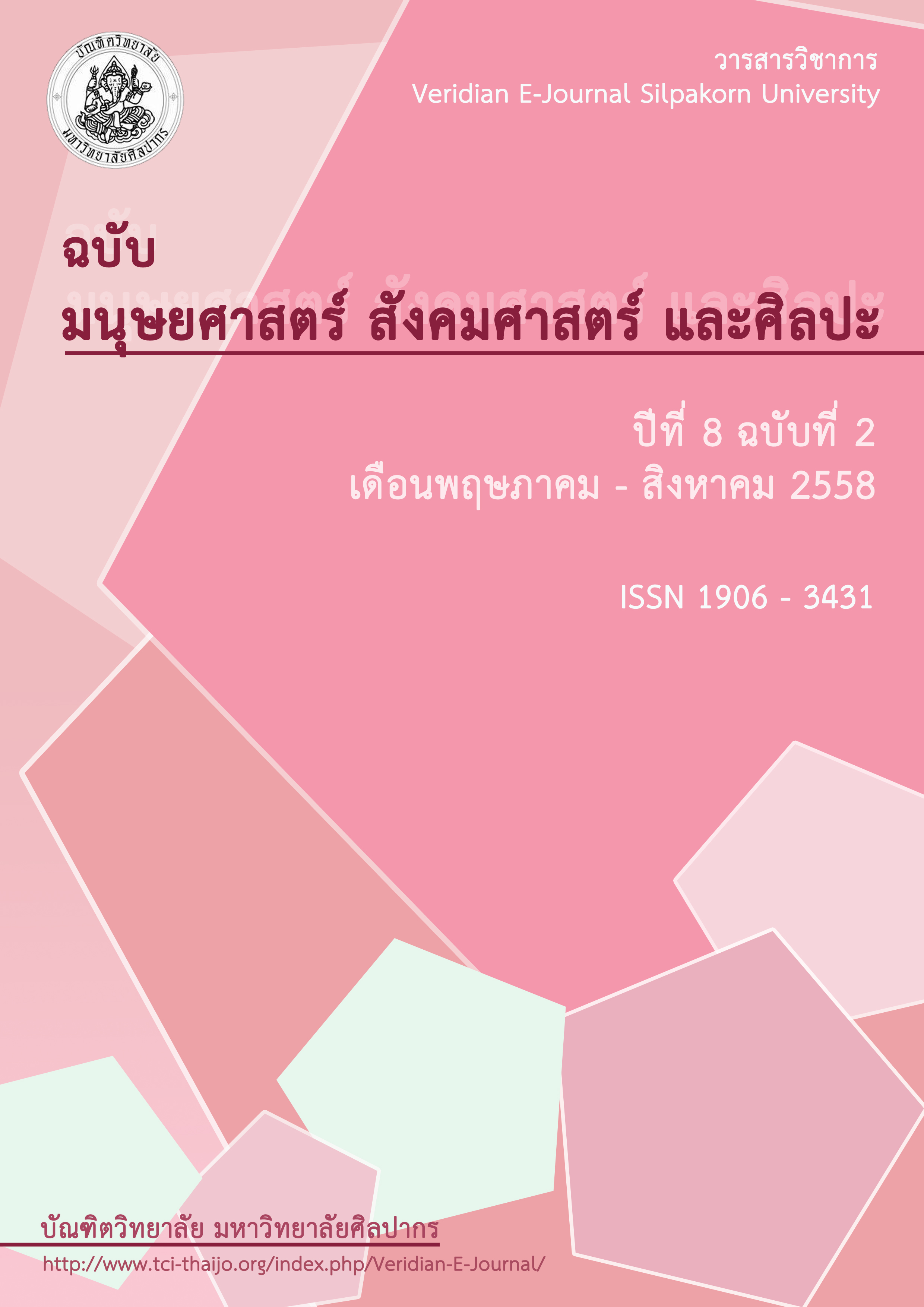ผลกระทบทางสายตาของอาคารสูงเพื่อการอยู่อาศัยที่มีต่อวัดในบริเวณกรุงเทพมหานคร
Main Article Content
Abstract
การวิจัยนี้มีจุดมุ่งหมายที่จะศึกษาผลกระทบทางสายตาของอาคารสูงเพื่อการอยู่อาศัยที่ก่อสร้างใกล้วัด เพื่อทำความเข้าใจผลกระทบ และหาแนวทางในการป้องกันหรือแก้ไข โดยใช้กรอบวิธีการประเมินคุณภาพเชิงทัศน์ (Visual Impact Assessment) ที่เคยมีการศึกษามาแล้วทั้งในประเทศและต่างประเทศ เช่น วิธีการจัดทำแบบสอบถามตามคู่มือการประเมินผลกระทบทางสายตาจากสิ่งก่อสร้างประเภทอาคาร (รุจิโรจน์ อนามบุตร และวิลาสินี สุขสว่าง, 2555) เป็นต้น
ขั้นตอนการวิจัยแบ่งเป็น 5 ส่วนหลัก คือ 1) ศึกษา และเลือกสำรวจวัดที่มีความสำคัญ ความเก่า แก่และมีคุณค่าทางประวัติศาสตร์และศิลปสถาปัตยกรรมแตกต่างกัน ซึ่งตั้งอยู่ในย่านที่มีความเป็นไปได้สูงที่จะเกิดการพัฒนาของอาคารสูงเพื่อการอยู่อาศัย 2) กำหนดตัวแปรในการวิจัย โดยการค้นคว้าจากเอกสาร การประเมินโดยผู้เชี่ยวชาญ และการจัดทำแบบสอบถามฉบับทดลอง 3) เลือกวัดตัวแทน และจัดทำภาพเชิงซ้อนของวัดที่มีอาคารสูงซ้อนทับอยู่ด้านหลัง (Photomontage) 4)เก็บข้อมูลจากกลุ่มเป้าหมายโดยใช้การสัมภาษณ์ด้วยแบบสอบถามประกอบรูปภาพ (Photo-questionnaire) และให้คะแนนรูปภาพบน Likert scale 6 ระดับ รวมถึงแสดงความคิดเห็นเพิ่มเติม 5) ประมวลผลข้อมูลโดยวิธีทางสถิติและสรุปผล
ผลการวิจัยพบว่าอาคารสูงที่พัฒนาขึ้นมาใกล้วัดมีผลกระทบทางสายตาในทางลบต่อวัดในทุกลักษณะ ทั้งวัดที่มีอาคารในฉากหลังและวัดที่ไม่มีอาคารในฉากหลังอยู่แต่แรก โดยมีระดับผลกระทบต่างกันขึ้นอยู่กับหลายปัจจัย ปัจจัยที่มีความสัมพันธ์กับระดับผลกระทบทางสายตามากที่สุด คือ ฉากหลังของภาพวัด รองลงมาคือ ความสูงของอาคารสร้างใหม่ในภาพวัด ตำแหน่งของอาคารสร้างใหม่ในภาพวัด และลักษณะ เฉพาะบุคคลของผู้ตอบแบบสอบถาม ตามลำดับ
ผลจากการวิจัยนี้สามารถนำไปปรับใช้เพื่อเป็นแนวทางการลดผลกระทบทางสายตาของอาคารสูงเพื่อการอยู่อาศัยที่มีต่อวัดในบริเวณกรุงเทพมหานครให้แก่หน่วยงานที่เกี่ยวข้องผู้ออกแบบกลุ่มธุรกิจอสังหาริมทรัพย์ และหน่วยงานของวัด เพื่อให้เกิดความสมดุลระหว่างการพัฒนาเมือง และการอนุรักษ์ความสวยงามของวัด หรือสถานที่สำคัญต่อไป
AbstractThe research aims to study the visual impact of tall residential buildings being developed near temples in order to understand the visual impact and find the ways for prevention or mitigation. The research framework is applied from the principle of Visual Impact Assessment (VIA).
The methodology can be described in 5 main parts; 1) Study the areas with high possibility for developments of tall residential building, temples in the areas were selected as case studies. 2) From literature review, factors which may affect visual quality in this situation were selected. 3) Representative pictures of temples were selected, photomontage technique was applied on selected pictures to depict the appearance of mock-up tall buildings on the background of the temples. 4) Data was collected from target group using a face-to-face interview with Photo-questionnaire. Participants were asked to give a preference and acceptability ratings on a 6-point Likert Scale for each photo and to give reasons or additional opinions. 5) Data collected were analyzed using a statistical package and the findings were reported and discussed.
The findings reveal that the developments of tall residential buildings near temples have negative visual impact on temples in all situations explored. The magnitude of impact depends on several factors. The most influential factors are, existing appearance of the background of the temples, the height and the position of simulated building in the picture, and personal characteristics of the participants respectively.
The research results may be applied as guidelines for prevention or mitigation of visual impact of tall residential buildings on nearby temples in Bangkok area for designers real estate developers as well as responsible authorities.
